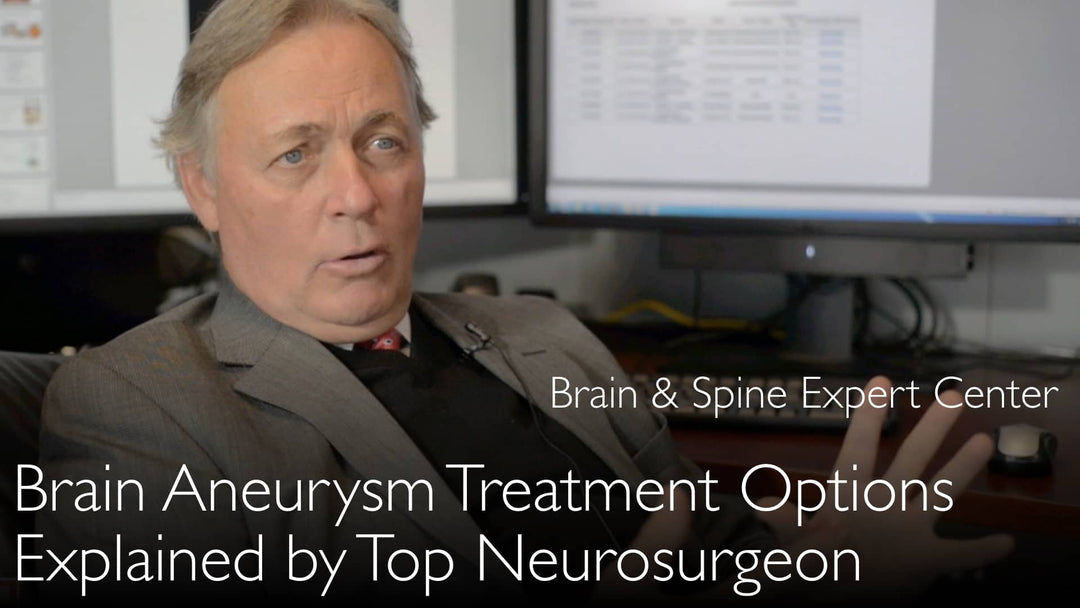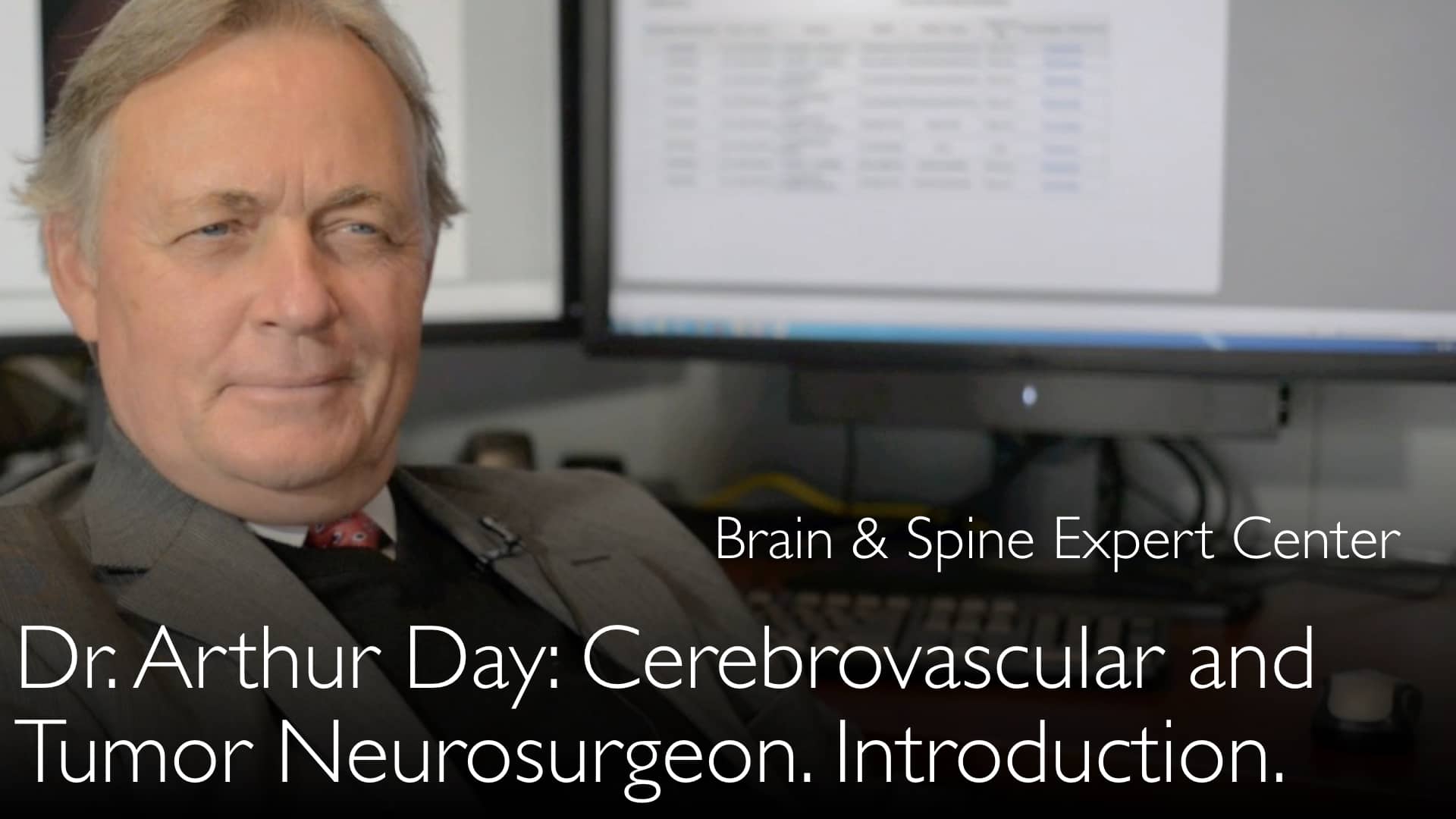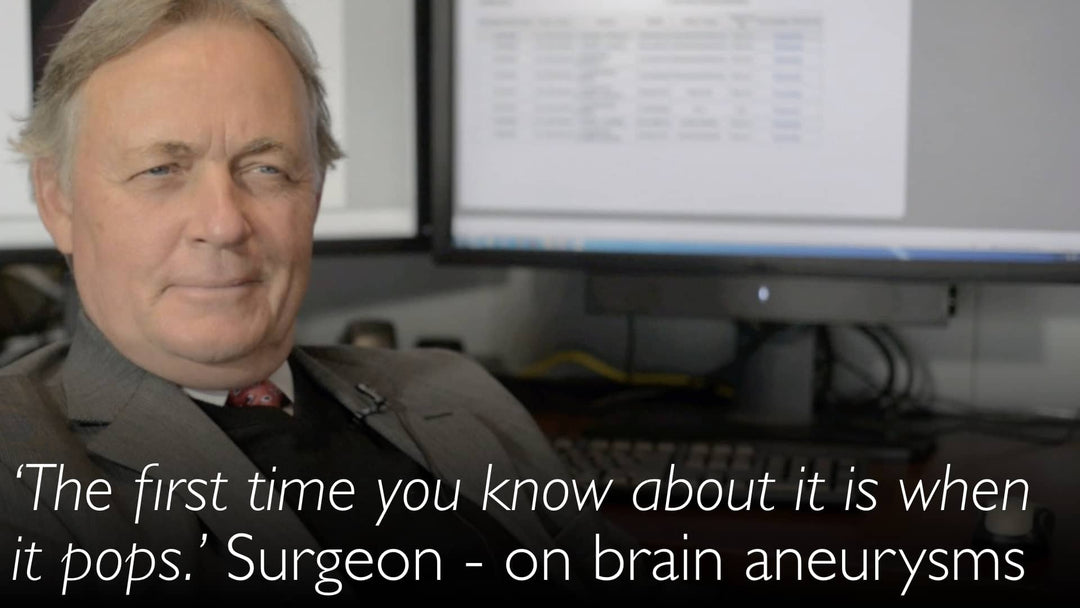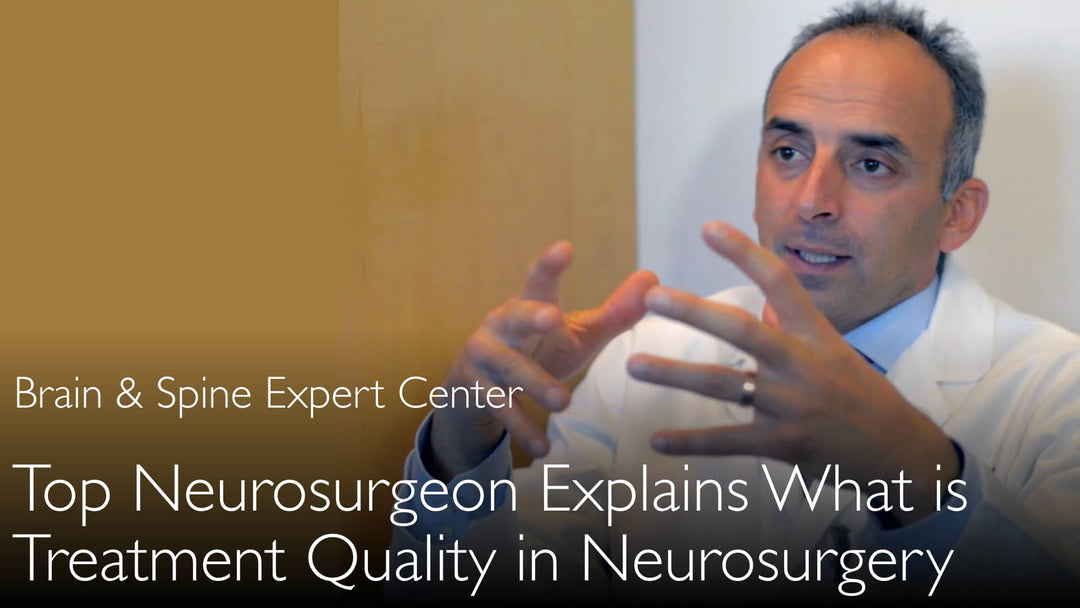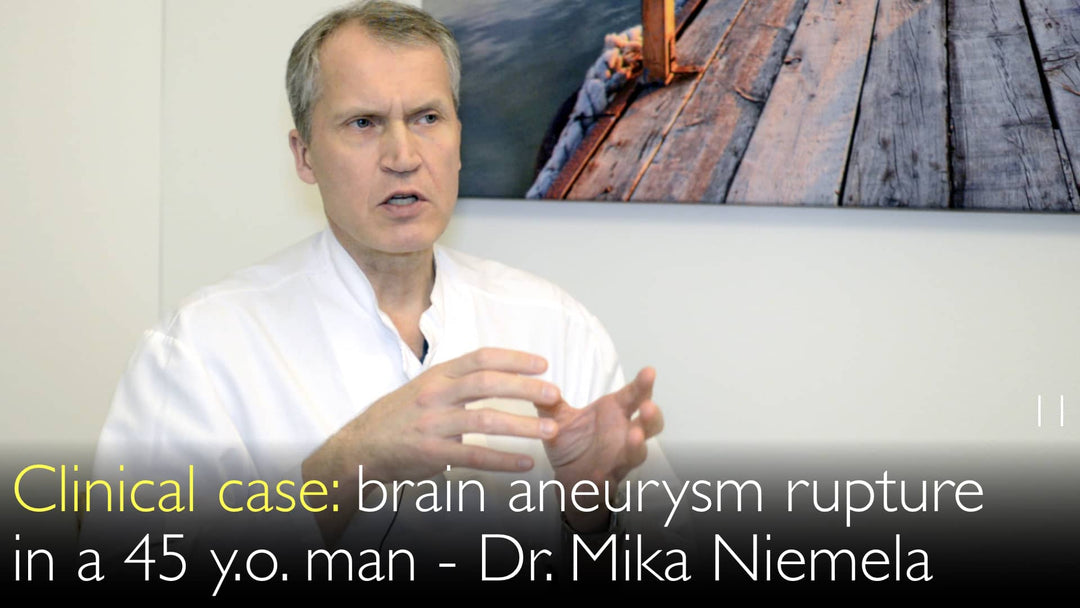Leading expert in cerebrovascular neurosurgery, Dr. Arthur Day, MD, explains the critical differences between brain aneurysm clipping and coiling procedures. He details how a ruptured brain aneurysm causes catastrophic bleeding with a 50% survival rate and emphasizes that a medical second opinion is essential for both ruptured and unruptured aneurysm diagnosis and treatment planning. Dr. Day compares the long-term durability of open surgical clipping against the less invasive endovascular coiling method, outlining key factors like patient age and neurological deficits that guide the optimal treatment choice for each individual.
Brain Aneurysm Treatment: Comparing Clipping vs. Coiling Procedures
Jump To Section
- What is a Brain Aneurysm?
- Symptoms and Discovery of Brain Aneurysms
- Diagnosing a Ruptured Brain Aneurysm
- Treatment Options: Surgical Clipping
- Treatment Options: Endovascular Coiling
- Choosing the Best Treatment Method
- The Role of Medical Second Opinion
What is a Brain Aneurysm?
A brain aneurysm is a dangerous dilation of a cerebral artery. Dr. Arthur Day, MD, describes it as a weak spot in an artery wall that balloons out under pressure from blood flow. This ballooning, or bubbling, can increase in size over time. The primary risk is that the aneurysm wall will eventually rupture, causing a catastrophic bleed into the head, a condition known as a subarachnoid hemorrhage.
Brain aneurysms are distinct from other cerebrovascular problems like arteriovenous malformations (AVMs), which are congenital tangles of arteries and veins. However, AVMs can sometimes lead to the formation of brain aneurysms. Dr. Arthur Day, MD, notes that most people are completely unaware they have an aneurysm until a life-threatening emergency occurs.
Symptoms and Discovery of Brain Aneurysms
Brain aneurysm symptoms are often absent until a rupture happens. Dr. Arthur Day, MD, explains that these vascular weaknesses typically develop later in life, more often in women in their forties or fifties, though they can occur earlier, especially with a strong genetic history. The growth is gradual, akin to a weak spot on a car tire that eventually leads to a blowout.
Warning symptoms are rare but can occur if a large, unruptured aneurysm presses on a nerve or brain structure. More commonly, the first sign is the rupture itself, which causes a sudden, severe "thunderclap" headache. Increasingly, unruptured brain aneurysms are discovered incidentally during MRI or CT scans performed for unrelated reasons, such as after a car accident. This accidental discovery allows for treatment before a potentially fatal rupture.
Diagnosing a Ruptured Brain Aneurysm
Diagnosing the cause of a brain bleed begins with a head CT scan. Dr. Arthur Day, MD, states that a CT scan can easily show blood in the brain, and the pattern of bleeding can help identify its source, such as trauma, a ruptured aneurysm, or an AVM. To confirm a structural vascular abnormality like an aneurysm, further imaging is required.
The gold standard diagnostic test is a cerebral angiogram. This invasive procedure involves injecting contrast dye into the brain's arteries to visualize them in detail. Non-invasive alternatives like CT angiography (CTA) or MR angiography (MRA) can also provide enough detail to identify a brain aneurysm or AVM, though they are not as definitive as a traditional angiogram.
Treatment Options: Surgical Clipping
Surgical clipping is a definitive open brain surgery procedure for treating a brain aneurysm. Dr. Arthur Day, MD, explains that a neurosurgeon opens the skull, locates the aneurysm, and places a tiny metal clip across its neck. This isolates the aneurysm from the bloodstream, preventing it from rupturing or re-bleeding.
This method offers a permanent cure. Dr. Arthur Day, MD, emphasizes that clipping is often the preferred treatment for younger, healthier patients because it eliminates the aneurysm forever. A key additional benefit of open surgery is the ability to drain any blood clot that has formed from the rupture, which can relieve pressure on the brain and help treat neurological deficits—something that cannot be achieved with less invasive methods.
Treatment Options: Endovascular Coiling
Endovascular coiling is a minimally invasive alternative to open surgery for brain aneurysm treatment. Dr. Arthur Day, MD, describes how a neurosurgeon or interventional radiologist threads a catheter through an artery to the site of the aneurysm. Through this catheter, soft platinum coils are deployed into the aneurysm sac.
These coils promote blood clotting within the aneurysm, effectively sealing it off. While coiling has a lower initial morbidity rate than open surgery, Dr. Arthur Day, MD, notes a significant drawback: a small but real probability that the aneurysm could recur many years later. Furthermore, coiling does not change the size of the aneurysm or allow for the removal of any blood clots that may be causing pressure on the brain.
Choosing the Best Treatment Method
Choosing between brain aneurysm clipping and coiling requires a multidisciplinary team approach. Dr. Arthur Day, MD, stresses that the ideal scenario involves experts in both open and endovascular neurosurgery who can objectively recommend the best option for each patient. Relying on a specialist who only performs one technique can bias the treatment plan.
Several critical factors guide this decision. These include the patient's age and overall health, the specific anatomy and location of the aneurysm, the surgeon's skill, and the severity of the patient's condition after a rupture. For a young, healthy patient, the permanence of surgical clipping is often favored. If a large blood clot is causing neurological deficits, open surgery becomes necessary to drain it and relieve pressure.
The Role of Medical Second Opinion
Obtaining a medical second opinion is crucial for both ruptured and unruptured brain aneurysm cases. Dr. Arthur Day, MD, repeatedly highlights that a second opinion confirms the accuracy of the initial diagnosis from imaging like angiography. It also ensures that the proposed treatment plan—whether it be observation, clipping, or coiling—is truly the best and most appropriate option for the individual patient.
This process provides patients and families with confidence in their care pathway. Given the high stakes of a brain aneurysm rupture, which carries a 50% mortality rate, and the complexity of the treatment options, a second opinion from an experienced cerebrovascular team is an essential step for optimal outcomes. Dr. Anton Titov, MD, concurs that this due diligence is a cornerstone of modern, patient-centered neurosurgical care.
Full Transcript
Dr. Anton Titov, MD: Two treatment options for brain aneurysms compared by a prominent cerebrovascular neurosurgeon. What causes brain aneurysms? What are symptoms of cerebral aneurysms? How to find out if you have a brain aneurysm? How to avoid death from ruptured brain aneurysm? Should you treat unruptured cerebral aneurysm? Is "clipping" or "coiling" the preferred method of brain aneurysm treatment?
Dr. Anton Titov, MD: How do you know if you're having a brain aneurysm?
Dr. Arthur Day, MD: Sometimes cerebral aneurysms rupture. Brain aneurysm survival rate is approximately 50%. Unruptured brain aneurysm treatment should be considered after careful assessment and medical second opinion from several specialists. Medical second opinion is also required to treat ruptured brain aneurysm.
Dr. Arthur Day, MD: Often open brain surgery and clipping is preferred for definitive treatment of ruptured brain aneurysms. Brain aneurysm treatment without surgery is possible by endovascular coiling. Endovascular aneurysm coiling has small morbidity. Treatment for brain aneurysms requires medical second opinion in all situations.
Brain aneurysms: to operate or not to operate? You need medical second opinion to decide. Ruptured brain aneurysms can be treated by aneurysm clipping. This is a preferred method to treat ruptured brain aneurysms if patient can tolerate the surgery.
Video interview with leading expert in cerebrovascular neurosurgery and minimally invasive neurosurgery. Medical second opinion confirms that cerebral aneurysm diagnosis is correct and complete.
Dr. Anton Titov, MD: Medical second opinion also confirms that brain aneurysm angiography is required. Medical second opinion helps to choose the best treatment for intracranial aneurysm. Get medical second opinion on brain aneurysm and be confident that your treatment is the best.
Dr. Arthur Day, MD: Brain aneurysms and cerebral arteriovenous malformations are common problems.
Dr. Anton Titov, MD: Can you briefly describe what is a brain aneurysm?
Dr. Arthur Day, MD: The term aneurysm refers to a dilated blood vessel. Most brain aneurysms arise from arteries because arteries are under pressure. Arteries develop a weak spot that starts to expand. It starts to balloon or to bubble. That balloon increases in size and it eventually may rupture and cause a catastrophic bleeding into the head.
Brain arteriovenous malformations are other cerebrovascular problems. Cerebral arteriovenous malformations have a congenitally malformed area. The arteries and veins in this area connect in an abnormal way. This can lead to problems. One problem is a formation of brain aneurysms. Another problem is bleeding into the brain.
Dr. Arthur Day, MD: Many people do not know that they have an aneurysm or arteriovenous malformation in the brain. Then an emergency happens.
Dr. Anton Titov, MD: What is the natural course of brain aneurysms and cerebral arteriovenous malformations?
Dr. Arthur Day, MD: Most brain aneurysms develop in later life. Brain aneurysms more typically develop in women in their forties or fifties. Brain aneurysms can develop earlier. There may be a strong genetic history of cerebral aneurysms. There may be a presence of unusual circumstances.
Brain aneurysms form because there is a weakness in the artery. The course of time and the pressure from heart beats and the pumping of blood from the heart cause this arterial weakness to grow. This brain artery weakness (a brain aneurysm) starts to show up. It is like a car tire that is getting weak. This weakness starts to balloon out. Weak tire eventually causes a flat tire.
There are usually no warnings that aneurysm exists in the brain.
Dr. Arthur Day, MD: Sometimes brain aneurysm grows bigger near a nerve or near some other brain anatomical structure. Then patient can have warning symptoms that cerebral aneurysm is getting ready to rupture. Usually the first time patients learn about a brain aneurysm is when brain aneurysm ruptures.
Sometimes brain aneurysm ruptures. Then it causes severe headache and often death. Sometimes a patient does not die from rupture of brain aneurysm. Then neurosurgeons can treat aneurysm to make sure cerebral aneurysm rupture does not happen again.
Brain MRI and CT scans are now done more often for some other reason. For example, MRI and CT is done after a car accident. Such brain scans can show that the person has a brain aneurysm. Such cerebral aneurysm discovery is called incidental discovery.
In these patients we can treat brain aneurysms before they rupture and cause bleeding into the brain. Accidental discovery of unruptured brain aneurysms happens more often. This situation is happening more often now. People have more brain MRIs and CTs done for other medical problems. Sometimes we discover an unruptured brain aneurysm.
Dr. Arthur Day, MD: Let's imagine a person who developed a bad headache. They have a focal neurological deficit on neurological examination in an emergency room. There is loss of speech or loss of ability to move, or other sign of malfunction of nervous system, or loss of consciousness. This person will be brought to the hospital. Sometimes doctors discover that this patient has bleeding into the brain. They will ask a neurosurgeon to see this patient.
Dr. Anton Titov, MD: What will neurosurgeon do with this patient to diagnose the cause of bleeding into the brain? How to treat a cerebral aneurysm? Is there other cerebrovascular problem in this patient?
Dr. Arthur Day, MD: We first must find the cause of bleeding into the brain. Head CT scan ("cat scan") is the first diagnostic test to do. Head CT scan can easily show blood in the brain. Location and pattern of blood in the brain can help neurosurgeons to identify a cause of bleeding. For example, a head trauma or rupture of brain aneurysm is a cause of head bleeding. We can see a bleeding from cerebral arteriovenous malformation.
Head CT scan may hint that bleeding is caused by a structural vascular abnormality. For example, ruptured brain aneurysms, cerebral arteriovenous malformation can cause bleeding into the brain. We can then do a more detailed diagnostic test that shows us arteries and veins of the brain. This test is called arteriogram (angiography).
One way to do brain angiography is invasive. It involves puncture of artery in arm or leg and injecting X-ray contrast dye into the brain vessels to see the arteries and veins. Another method to see brain arteries and veins is a variation of brain MRI scan or brain CT scan. It is MRI angiography or CT angiography. This method is not invasive. It does not allow us to see brain arteries and veins as good as in an invasive classical angiogram. But MRI angiography or CT angiography usually provides enough details. We can understand that there is something wrong in the brain. It could be a brain aneurysm or brain arteriovenous malformation.
Dr. Arthur Day, MD: Sometimes ruptured brain aneurysm is indeed the cause of brain hemorrhage. Then two treatment methods can help such patient. One is open brain surgery. This is called "brain aneurysm clipping". Neurosurgeon opens the skull and finds the brain aneurysm.
Dr. Anton Titov, MD: Neurosurgeon then places a special metal clip across the neck of the brain aneurysm. Another treatment method is called "brain aneurysm coiling". This is endovascular neurosurgery method. Endovascular neurosurgeon puts a wire into artery of the patient. The wire reaches brain aneurysm from inside the artery. Neurosurgeon puts small coils to plug the aneurysm. These coils let the blood inside brain aneurysm to coagulate.
Dr. Anton Titov, MD: How to choose the best method of treatment of ruptured brain aneurysm? How to compare open brain surgery? There is "aneurysm clipping" and brain aneurysm “coiling”. Endovascular neurosurgeon does coiling of brain aneurysm. Which one of these two methods is better?
Dr. Arthur Day, MD: Obviously, the best method of treatment of ruptured brain aneurysm is to have a team of experts. Experts should understand both open brain surgery and endovascular neurosurgery. Such team of experts can choose the best treatment for each patient. Sometimes if you only know how to do one method of treatment, you treat all brain aneurysms the same way. Sometimes a doctor knows how to use only one method of treatment. This doctor will treat all patients in the same way.
But the ideal situation is to consider both open brain surgery method and endovascular neurosurgery method for each patient. Then team should pick the best method of treatment for that particular patient. Open surgical treatment of recently ruptured brain aneurysm cures the patient for the rest of patient's life. Surgical treatment (called "brain aneurysm clipping") is the best treatment in a young person who is in good physical shape. He is in a good state of health.
"Brain aneurysm coiling" by endovascular method has a small but real probability that aneurysm will form again after many years. So open brain surgery to treat brain aneurysm is the best method. It ensures that the brain aneurysm is gone forever. For younger patients we often do open brain surgery to cure them of aneurysm.
Sometimes a blood clot from ruptured brain aneurysm puts a pressure on a nerve in the brain. Or sometimes blood clot creates another neurologic deficit. Sometimes we do open brain surgery to clip the brain aneurysm. We can also drain the blood clot. This is formed in the brain after aneurysm rupture. This removes the pressure from the brain. It helps to treat neurologic deficit.
Therefore, neurosurgical operation offers the best chance to a patient to recover from a neurologic deficit. You cannot do that with endovascular method of treatment of ruptured brain aneurysm. "Brain aneurysm coiling" cannot clean up blood clot in the brain. Endovascular treatment also cannot remove pressure from the brain. Putting coils into the brain aneurysm leaves its size the same. Or it makes brain aneurysm bigger than it was before endovascular treatment.
Choosing the best treatment method for ruptured brain aneurysm depends on several factors: age of patient, skills of neurosurgeon, the severity of patient's clinical condition, and what symptoms does ruptured brain aneurysm cause. All this is in addition to brain aneurysm existence.
Dr. Anton Titov, MD: Two treatment options for brain aneurysms compared. Brain aneurysms: how they form? Who is at risk? To operate or not to operate unruptured brain aneurysm?


